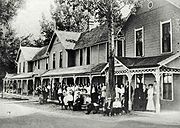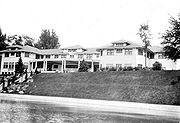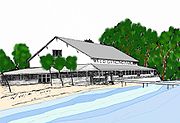
Lake Wawasee history
Encyclopedia

Freshwater
Fresh water is naturally occurring water on the Earth's surface in ice sheets, ice caps, glaciers, bogs, ponds, lakes, rivers and streams, and underground as groundwater in aquifers and underground streams. Fresh water is generally characterized by having low concentrations of dissolved salts and...
lake southeast of Syracuse
Syracuse, Indiana
Syracuse is a town in Turkey Creek Township, Kosciusko County, Indiana, United States. The population was 2,810 at the 2010 census.Syracuse is the location of Lake Syracuse and the nearby, larger Lake Wawasee, in addition to several other lakes in the region.-Geography:Syracuse is located at ...
in Kosciusko County, Indiana
Kosciusko County, Indiana
Kosciusko County is a county located in the U.S. state of Indiana. Census 2010 recorded the population at 77,358. The county seat is Warsaw.The county was formed in 1836. It was named after the Polish general Tadeusz Kościuszko, who served in the American Revolutionary War, and then returned to...
. It is the largest natural lake within Indiana's
Indiana
Indiana is a US state, admitted to the United States as the 19th on December 11, 1816. It is located in the Midwestern United States and Great Lakes Region. With 6,483,802 residents, the state is ranked 15th in population and 16th in population density. Indiana is ranked 38th in land area and is...
borders, and has an extensive and rich history.
Pre-glacial
Around 1 million years ago just prior to the Pleistocene epochPleistocene
The Pleistocene is the epoch from 2,588,000 to 11,700 years BP that spans the world's recent period of repeated glaciations. The name pleistocene is derived from the Greek and ....
, northern Indiana was covered by the Teays River
Teays River
The Teays River was an important preglacial river that drained much of the area now drained by the Ohio River, and more. Traces of the Teays across northern Ohio and Indiana are represented by a network of river valleys. These valleys were carved in the late Cenozoic and eventually led to the...
system which flowed northwest out of Virginia
Virginia
The Commonwealth of Virginia , is a U.S. state on the Atlantic Coast of the Southern United States. Virginia is nicknamed the "Old Dominion" and sometimes the "Mother of Presidents" after the eight U.S. presidents born there...
, West Virginia
West Virginia
West Virginia is a state in the Appalachian and Southeastern regions of the United States, bordered by Virginia to the southeast, Kentucky to the southwest, Ohio to the northwest, Pennsylvania to the northeast and Maryland to the east...
, and Ohio
Ohio
Ohio is a Midwestern state in the United States. The 34th largest state by area in the U.S.,it is the 7th‑most populous with over 11.5 million residents, containing several major American cities and seven metropolitan areas with populations of 500,000 or more.The state's capital is Columbus...
entering Indiana at Adams County
Adams County, Indiana
Adams County lies in northeastern Indiana in the United States and shares its eastern border with Ohio. It was officially established in 1836. The county seat is Decatur....
and flowed about 45 miles (72 km) south of what is now Lake Wawassee.
Post glacial
After the last glaciation period, the land was left with kettle holes and hilly moraineMoraine
A moraine is any glacially formed accumulation of unconsolidated glacial debris which can occur in currently glaciated and formerly glaciated regions, such as those areas acted upon by a past glacial maximum. This debris may have been plucked off a valley floor as a glacier advanced or it may have...
s. The land supported large vast Picea evergreen forests, and Balsam poplar
Balsam poplar
The balsam poplars — also known as Populus sect. Tacamahaca — are a group of about 10 species of poplars, indigenous to North America and eastern Asia, distinguished by the balsam scent of their buds, the whitish undersides of their leaves, and the leaf petiole being round in cross-section...
, which gave way to hardwoods of oak
Oak
An oak is a tree or shrub in the genus Quercus , of which about 600 species exist. "Oak" may also appear in the names of species in related genera, notably Lithocarpus...
, poplar
Poplar
Populus is a genus of 25–35 species of deciduous flowering plants in the family Salicaceae, native to most of the Northern Hemisphere. English names variously applied to different species include poplar , aspen, and cottonwood....
and hickory
Hickory
Trees in the genus Carya are commonly known as hickory, derived from the Powhatan language of Virginia. The genus includes 17–19 species of deciduous trees with pinnately compound leaves and big nuts...
. Animal life consisted of Saber-toothed cat
Saber-toothed cat
Saber-toothed cat or Sabre-toothed cat refers to the extinct subfamilies of Machairodontinae , Barbourofelidae , and Nimravidae as well as two families related to marsupials that were found worldwide from the Eocene Epoch to the end of the Pleistocene Epoch ,...
, Mastodon
Mastodon
Mastodons were large tusked mammal species of the extinct genus Mammut which inhabited Asia, Africa, Europe, North America and Central America from the Oligocene through Pleistocene, 33.9 mya to 11,000 years ago. The American mastodon is the most recent and best known species of the group...
, Short-faced bear
Arctodus
Arctodus — known as the short-faced bear or bulldog bear — is an extinct genus of bear endemic to North America during the Pleistocene ~3.0 Ma.—11,000 years ago, existing for approximately three million years. Arctodus simus may have once been Earth's largest mammalian, terrestrial carnivore...
, dire wolf
Dire Wolf
The Dire Wolf, Canis dirus, is an extinct carnivorous mammal of the genus Canis, and was most common in North America and South America from the Irvingtonian stage to the Rancholabrean stage of the Pleistocene epoch living 1.80 Ma – 10,000 years ago, existing for approximately .- Relationships...
, Ground sloth
Ground sloth
Ground sloths are a diverse group of extinct sloths, in the mammalian superorder Xenarthra. Their most recent survivors lived in the Antilles, where it has been proposed they may have survived until 1550 CE; however, the youngest AMS radiocarbon date reported is 4190 BP, calibrated to c. 4700 BP...
, Giant Beaver
Giant Beaver
Castoroides ohioensis was a species of giant beaver, huge members of the family Castoridae , endemic to North America during the Pleistocene epoch .-Morphology:...
, Peccary
Platygonus
Platygonus is an extinct genus of herbivorous peccary of the family Tayassuidae, endemic to North America from the Miocene through Pleistocene epochs , existing for approximately ....
, Stag-moose
Stag-moose
The stag-moose or stag moose was a large, moose-like deer of North America of the Pleistocene epoch. It was slightly larger than the moose, with an elk-like head, long legs, and complex, palmate antlers...
and Ancient bison. Lakes would have sturgeon
Lake sturgeon
The lake sturgeon is a North American temperate freshwater fish, one of about 20 species of sturgeon. Like other sturgeons, this species is an evolutionarily ancient bottomfeeder with a partly cartilaginous skeleton and skin bearing rows of bony plates...
, whitefish
Lake whitefish
The lake whitefish , also called the Sault whitefish or gizzard fish, is a species of freshwater whitefish from North America. Lake whitefish are found throughout much of Canada and parts of the northern United States, including all of the Great Lakes. A valuable commercial fish, they are also...
, pike
Northern Pike
The northern pike , is a species of carnivorous fish of the genus Esox...
, pickerel
American pickerel
The American pickerels are two subspecies of Esox americanus, a species of freshwater fish in the pike family of order Esociformes: the redfin pickerel, E. americanus americanus Gmelin, 1789, and the grass pickerel, E. americanus vermiculatus Lesueur, 1846.Both subspecies are native to North America...
, muskellunge
Muskellunge
A muskellunge , also known as a muskelunge, muscallonge, milliganong, or maskinonge , is a large, relatively uncommon freshwater fish of North America. Muskellunge are the largest member of the pike family, Esocidae...
as well as smaller fish such as bluegill
Bluegill
The Bluegill is a species of freshwater fish sometimes referred to as bream, brim, or copper nose. It is a member of the sunfish family Centrarchidae of the order Perciformes.-Range and distribution:...
, redear sunfish
Redear sunfish
The redear sunfish , also known as the shellcracker, Georgia bream, cherry gill, chinquapin, improved bream, rouge ear sunfish and sun perch, is native to the southeastern United States, but since it is a popular sport fish it has been introduced to bodies of water all over North America...
, black bass
Black bass
Micropterus , is a genus of freshwater fish in the sunfish family of order Perciformes. The type species is M. dolomieu, the smallmouth bass...
, yellow perch
Yellow perch
The yellow perch is a species of perch found in the United States and Canada, where it is often referred to by the shortform perch. Yellow perch look similar to the European perch, but are paler and more yellowish, with less red in the fins. They have six to eight dark, vertical bars on their sides...
, and catfish
Catfish
Catfishes are a diverse group of ray-finned fish. Named for their prominent barbels, which resemble a cat's whiskers, catfish range in size and behavior from the heaviest and longest, the Mekong giant catfish from Southeast Asia and the second longest, the wels catfish of Eurasia, to detritivores...
.
Beach formations and peat
Peat
Peat is an accumulation of partially decayed vegetation matter or histosol. Peat forms in wetland bogs, moors, muskegs, pocosins, mires, and peat swamp forests. Peat is harvested as an important source of fuel in certain parts of the world...
beds indicate Wawasee was 7 to 8 feet (2.1 - 2.4 m) deeper than present. Continuing running water through the outlet to the north lowered the lake level 6 to 7 feet (2 m). A dam built in 1834 consequently raised the level back to where it is today.
The 1800s
Prior to white menWhite people
White people is a term which usually refers to human beings characterized, at least in part, by the light pigmentation of their skin...
coming to Turkey Lake, it was the tribal lands of Miami Indian chiefs
Tribal chief
A tribal chief is the leader of a tribal society or chiefdom. Tribal societies with social stratification under a single leader emerged in the Neolithic period out of earlier tribal structures with little stratification, and they remained prevalent throughout the Iron Age.In the case of ...
Wawasee
Wawasee
Wawasee or Wawaausee often contracted into Wawbee and known as was a Miami chief who lived in what is now Kosciusko County, Indiana, in the United States...
and Papakeecha
Papakeecha
Papakeecha or meaning "Flat Belly" was the most influential Miami chief in the region around Lake Wawasee, in what is now Kosciusko County, Indiana, United States leading his people from 1820 until 1837. Lake Papakeechie was named after him.Papakeecha was about 60 years old when white men entered...
. Wawasee was a signatory to the Treaty of Mississinwas
Treaty of Mississinwas
The Treaty of Mississiniwas or the Treaty of Mississinewa is an 1826 treaty between the United States and the Miami tribe.-Terms:After negotiations with the Pottawatomie to build the Michigan Road through Indiana by James B...
and in 1828 was alloted a small village approximately two and one-half miles southeast of Milford
Milford, Indiana
Milford could refer to:*Milford, Decatur County, Indiana*Milford, Kosciusko County, Indiana*Former name of Green Hill, Indiana...
and northeast of Wabee Lake
Wabee Lake
Wabee Lake is a small lake situated 2 miles southeast of Milford, Kosciusko County, Indiana, United States.Wabee is typical in structure of natural lakes of the glaciated portions of the upper Midwest. Like other lakes in the general area, Wabee is lined with vacation homes and year-round residences...
where the town of Syracuse is located. It also included the eastern shores of Turkey Lake (Lake Wawasee) effectively bisect
Bisect
Bisection is the general activity of dividing something into two equal parts.Bisect may mean:*bisection, in geometry, dividing something into two equal parts* bisection of earthworms to study regeneration...
ing the lake in half with the southern half going to his brother.
White men began coming into the area in the early 1830s and called the lake Turkey Lake. In 1834 the U.S. government deeded the land to the Wabash and Erie Canal
Wabash and Erie Canal
The Wabash and Erie Canal was a shipping canal that linked the Great Lakes to the Ohio River via an artificial waterway. The canal provided traders with access from the Great Lakes all the way to the Gulf of Mexico...
who later sold it to Charles R. Ogden in 1875. Ownership was passed on to "Uncle" Billy Moore in 1877. Early settlers were homesteaders
Homesteading
Broadly defined, homesteading is a lifestyle of simple self-sufficiency.-Current practice:The term may apply to anyone who follows the back-to-the-land movement by adopting a sustainable, self-sufficient lifestyle. While land is no longer freely available in most areas of the world, homesteading...
who earned their livelihoods by hunting, fishing, and trapping with a little farming.
Cedar Point
Cedar Point is on Wawasee's eastern shore and is a glacial kameKame
A kame is a geological feature, an irregularly shaped hill or mound composed of sand, gravel and till that accumulates in a depression on a retreating glacier, and is then deposited on the land surface with further melting of the glacier...
formed by a sub-glacial stream. This ground was inhabited by the Glacial Kame Culture that resided here from 8000 BC to 1000 BC. Indications of trade with tribes in the southern United States is evidenced by shells found from the Gulf of Mexico
Gulf of Mexico
The Gulf of Mexico is a partially landlocked ocean basin largely surrounded by the North American continent and the island of Cuba. It is bounded on the northeast, north and northwest by the Gulf Coast of the United States, on the southwest and south by Mexico, and on the southeast by Cuba. In...
cut and sized to look like the sole of a shoe and circular disks 3 inches (7.6 cm) to 5 inches (12 cm) worn around the neck. Human bones were found protruding from holes in the rock face in the 1880s and often later development unearthed artifacts
Artifact (archaeology)
An artifact or artefact is "something made or given shape by man, such as a tool or a work of art, esp an object of archaeological interest"...
and skeltel
Skeleton
The skeleton is the body part that forms the supporting structure of an organism. There are two different skeletal types: the exoskeleton, which is the stable outer shell of an organism, and the endoskeleton, which forms the support structure inside the body.In a figurative sense, skeleton can...
material. In the 1870s or 1880s Cedar Point was inhabited by a single recluse. From the 1940s through 1950s ancient fireplace
Fireplace
A fireplace is an architectural structure to contain a fire for heating and, especially historically, for cooking. A fire is contained in a firebox or firepit; a chimney or other flue allows gas and particulate exhaust to escape...
s made of groupings of burned and cracked stones were found on the top of Cedar Point.
Cedar Point was the best authenticated site of Paleoindians' existence along Wawasee's shore. During the early 20th century the ground was leveled off to use for fill disturbing the natural look of Cedar Point. Today it is home to many summer homes and year round residents.
Conkling Hill
Conkling Hill was named after a William Conking, a settler and possible sailor during the War of 1812War of 1812
The War of 1812 was a military conflict fought between the forces of the United States of America and those of the British Empire. The Americans declared war in 1812 for several reasons, including trade restrictions because of Britain's ongoing war with France, impressment of American merchant...
who came to the area in the 1830s with his wife. In 1844 a visitor by the name of P.M. Henkle visited for a day or two of fishing recounted a small cabin with one bed. Conkling Hill was acquired by a church group in 1894 and became Oakwood Park. Today it is a 42 acres (169,968.1 m²) religious retreat called Oakwood Foundation.(Lilly, Eli)
Morrison's Island
Morrison's Island was originally Eagle Island when the first white settlers arrived because of the bald eagleBald Eagle
The Bald Eagle is a bird of prey found in North America. It is the national bird and symbol of the United States of America. This sea eagle has two known sub-species and forms a species pair with the White-tailed Eagle...
s nesting there. Eagle Island was also heavily forested with a variety of trees. Morrison's Island is located on Wawasee's south-southeast end overlooking Buttermilk Bay to the south and Johnson's Bay to the north. It was named after William T. Morrison, a Civil War
American Civil War
The American Civil War was a civil war fought in the United States of America. In response to the election of Abraham Lincoln as President of the United States, 11 southern slave states declared their secession from the United States and formed the Confederate States of America ; the other 25...
soldier who served with an Ohio regiment of the Union army
Union Army
The Union Army was the land force that fought for the Union during the American Civil War. It was also known as the Federal Army, the U.S. Army, the Northern Army and the National Army...
. Morrison moved to the area and applied for a position at the old frame schoolhouse once located at Washington Street and Harrison Street.
Morrison built a cabin on Eagle Island where he and his family lived until the 1890s. The house was eventually destroyed by fire. An unsubstantiated story says he took the insurance money and purchased a new shotgun
Shotgun
A shotgun is a firearm that is usually designed to be fired from the shoulder, which uses the energy of a fixed shell to fire a number of small spherical pellets called shot, or a solid projectile called a slug...
and melodeon
Melodeon (organ)
A melodeon is a type of 19th century reed organ with a foot-operated vacuum bellows, and a piano keyboard. It differs from the related harmonium, which uses a pressure bellows. Melodeons were manufactured in the United States sometime after 1812 until the Civil War era...
and moved into their barn
Barn
A barn is an agricultural building used for storage and as a covered workplace. It may sometimes be used to house livestock or to store farming vehicles and equipment...
. In the 20th century Morrison sold his island property for a good sum and moved to Oregon
Oregon
Oregon is a state in the Pacific Northwest region of the United States. It is located on the Pacific coast, with Washington to the north, California to the south, Nevada on the southeast and Idaho to the east. The Columbia and Snake rivers delineate much of Oregon's northern and eastern...
and in a short time was back in Indiana living very well in Ligonier
Ligonier, Indiana
Ligonier is a city in Perry Township, Noble County, Indiana, United States. The population was 4,405 at the 2010 census.-Geography:Ligonier is located at ....
on his increasing pension and proceeds
from his sale. Elwood George would successfully develop the island.
Kale Island
In 1862 or 1863 Kale Island was settled by two brothers by the name of Thomas and Kale Oram. They made their livelihoods catching fish by net for sale in GoshenGoshen, Indiana
Goshen is a city in and the county seat of Elkhart County, Indiana, United States. It is the smaller of the two principal cities of the Elkhart-Goshen Metropolitan Statistical Area, which in turn is part of the South Bend-Elkhart-Mishawaka Combined Statistical Area. It is located in the northern...
and cleared some 20 acres (80,937.2 m²) of land. Trees were floated through the main channel to a saw mill on Turkey Creek or one just south of Vawter Park. The poplar trees going to homes in Syracuse and oak made into barrel
Barrel
A barrel or cask is a hollow cylindrical container, traditionally made of vertical wooden staves and bound by wooden or metal hoops. Traditionally, the barrel was a standard size of measure referring to a set capacity or weight of a given commodity. A small barrel is called a keg.For example, a...
staves and firewood. The Oram brothers planted the area with Concord
Concord grape
Concord grapes are a cultivar derived from the grape species Vitis labrusca which are used as table grapes, wine grapes and juice grapes....
and Delaware grapes. During the Civil War
American Civil War
The American Civil War was a civil war fought in the United States of America. In response to the election of Abraham Lincoln as President of the United States, 11 southern slave states declared their secession from the United States and formed the Confederate States of America ; the other 25...
, Thomas Oram joined the Union army
Union Army
The Union Army was the land force that fought for the Union during the American Civil War. It was also known as the Federal Army, the U.S. Army, the Northern Army and the National Army...
and later moved to Kansas
Kansas
Kansas is a US state located in the Midwestern United States. It is named after the Kansas River which flows through it, which in turn was named after the Kansa Native American tribe, which inhabited the area. The tribe's name is often said to mean "people of the wind" or "people of the south...
. Kale later married a woman named "Mam" who lived with her son Bill in a lowly cabin on Syracuse Lake
Syracuse Lake
Syracuse Lake is a natural lake bordering Syracuse in Kosciusko County, Indiana, USA.- Location :Lake Syracuse is bordered on the west by N. Front Street, Pickwick Road and the B&O Railroad on the south. On the east its bordered by E. Shore Drive and on the north by E. Northshore Drive...
. They lived on Kale Island until 1874 when the land was purchased by Mart Hillabold during the building of the B&O Railroad
Baltimore and Ohio Railroad
The Baltimore and Ohio Railroad was one of the oldest railroads in the United States and the first common carrier railroad. It came into being mostly because the city of Baltimore wanted to compete with the newly constructed Erie Canal and another canal being proposed by Pennsylvania, which...
. Kale, Mam and her son moved to her cabin on Syracuse Lake.
In 1873 or 1874, John Wysong and March McCory built Island House on Kale Island, Lake Wawasee's first summer hotel. Badly built, it declined in popularity becoming a poker
Poker
Poker is a family of card games that share betting rules and usually hand rankings. Poker games differ in how the cards are dealt, how hands may be formed, whether the high or low hand wins the pot in a showdown , limits on bet sizes, and how many rounds of betting are allowed.In most modern poker...
and boozing
Booze
Booze is an informal term for an alcoholic beverage. It can also refer to:Places*Booze, North Yorkshire, an English hamletPeople*Bea Booze , American jazz singer*Tyrone Booze , American boxer...
hang-out and eventually burned down. Kale Island was finally acquired by George W. Miles who had it developed into an upscale area for homes.
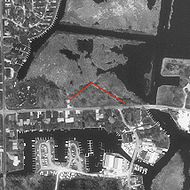
Dog Creek Dam
Dog Creek Dam and the "fish trap" were located just off the north side of E. Pickwick Drive on Kale Island. A continuation of this dam extended south toward the higher ground of Oakwood Park. The north and west sides of this dam formed the "fish trap" which flooded in the springtime. As waters receded, local settlers would then be able to net and pitchforkPitchfork
A pitchfork is an agricultural tool with a long handle and long, thin, widely separated pointed tines used to lift and pitch loose material, such as hay, leaves, grapes, dung or other agricultural materials. Pitchforks typically have two or three tines...
fish.
The outlet between Lake Wawasee and Syracuse Lake, which flowed westward between the south and north embankments of Dog Creek Dam. It was an ideal site for a grist mill and was made by creating a millrace
Sluice
A sluice is a water channel that is controlled at its head by a gate . For example, a millrace is a sluice that channels water toward a water mill...
at that point. The first mill was built in 1834 by Sam Crosson and Henry Ward. It was destroyed somewhat quickly by either being washed away in spring flood
Flood
A flood is an overflow of an expanse of water that submerges land. The EU Floods directive defines a flood as a temporary covering by water of land not normally covered by water...
ing or by sinking into a soft bog
Bog
A bog, quagmire or mire is a wetland that accumulates acidic peat, a deposit of dead plant material—often mosses or, in Arctic climates, lichens....
which were numerous in Kosciusko County. The two mill stones can be seen on the north side of Kale Island and to the east of the main channel through one of the many minor channels.
Cedar Beach Club
The Cedar Beach Club was established in 1880 and was the first hotel on this site. The property was purchased by the North Lake and River Association. Judge John V. Pettit of Wabash, IndianaWabash, Indiana
Wabash is a city in Noble Township, Wabash County, Indiana, United States. The population was 10,666 at the 2010 census. The city is the county seat of Wabash County....
became president of the association with individuals from northern Indiana towns of Alexandria
Alexandria, Indiana
Alexandria is a city in Monroe Township, Madison County, Indiana, United States. It is about northeast of Indianapolis. It is part of the Anderson, Indiana Metropolitan Statistical Area...
, Goshen
Goshen, Indiana
Goshen is a city in and the county seat of Elkhart County, Indiana, United States. It is the smaller of the two principal cities of the Elkhart-Goshen Metropolitan Statistical Area, which in turn is part of the South Bend-Elkhart-Mishawaka Combined Statistical Area. It is located in the northern...
, Peru
Peru, Indiana
-Demographics:As of the census of 2000, there were 12,994 people, 5,410 households, and 3,397 families residing in the city. The population density was 2,815.5 people per square mile . There were 5,943 housing units at an average density of 1,287.7 per square mile...
, Wabash
Wabash, Indiana
Wabash is a city in Noble Township, Wabash County, Indiana, United States. The population was 10,666 at the 2010 census. The city is the county seat of Wabash County....
, and Huntington
Huntington, Indiana
Huntington, known as the "Lime City", is a small city in and the county seat of Huntington County, Indiana, United States. It is in Huntington Township and Union Township...
joining and all of which were followers of Izaac Walton which would later produce the Izaak Walton League
Izaak Walton League
The Izaak Walton League is an American environmental organization founded in 1922 that promotes natural resource protection and outdoor recreation. The organization was founded in Chicago, Illinois by a group of sportsmen who wished to protect fishing opportunities for future generations...
an early environmental group. A simple oblong, two-story, gabled roof
Gable
A gable is the generally triangular portion of a wall between the edges of a sloping roof. The shape of the gable and how it is detailed depends on the structural system being used and aesthetic concerns. Thus the type of roof enclosing the volume dictates the shape of the gable...
club house was constructed with 50 bedrooms and a 125 seat dining room. The North Lake and River Association financially collapsed in 1882 with the property being sold by the sheriff to the Cedar Beach Association. In 1887 the property was transferred to the Cedar Beach Club for $7000. James B. Suitt of Indianapolis
Indianapolis
Indianapolis is the capital of the U.S. state of Indiana, and the county seat of Marion County, Indiana. As of the 2010 United States Census, the city's population is 839,489. It is by far Indiana's largest city and, as of the 2010 U.S...
was the president of the club which included James T. Layman, an Indianapolis wholesaler who had served on the Indianapolis City Common Council and Board of Aldermen 1877-1884. Addison H. Nordyke
Addison H. Nordyke
Addison H. Nordyke was an industrialist and manufacturer from Richmond, Indiana, United States.In 1858 Addison H. Nordyke and his father, Ellison Nordyke, formed a partnership in to manufacture and build flour mills. The company was named E. & A. H. Nordyke with a small building just behind Ellis...
, flour mill manufacturer. William H. Holliday, F.T. Holliday, J.A. Lemcke, Robert W. Cathcart, John H. Spann, Thomas H. Spann. In 1891 the club burned. It had the first seawall on Wawasee made of logs.
The Jones Hotel
The Jones Hotel, established in September 1881 on the north shore of the lake just east of Willow Grove, was the first major establishment for entertainment on Turkey Lake. It was built by Abram M. Jones, a native of Mansfield, OhioMansfield, Ohio
Mansfield is a city in the U.S. state of Ohio and the county seat of Richland County. The municipality is located in north-central Ohio in the western foothills of the Allegheny Plateau, approximately southwest of Cleveland and northeast of Columbus....
, who served with the 2nd Ohio Cavalry during the Civil War
American Civil War
The American Civil War was a civil war fought in the United States of America. In response to the election of Abraham Lincoln as President of the United States, 11 southern slave states declared their secession from the United States and formed the Confederate States of America ; the other 25...
. In 1875 Jones, his wife Mary Duff Jones, and 2 sons moved to Syracuse. Jones was a mechanical engineer for the B&O Railroad while in Mansfield and continued working for the railroad in Syracuse as operator of the pumping station. Jones also operated the Syracuse grain elevator
Grain elevator
A grain elevator is a tower containing a bucket elevator, which scoops up, elevates, and then uses gravity to deposit grain in a silo or other storage facility...
.
The Jones Hotel was a successful endeavor from its inception serving great meals to its patrons and visitors. The rooms were said to be comfortable. The hotel had a barn behind it where many of Wawasee's early boats and yachts were built. The Jones Hotel was sold in 1920 to Mr. M. E. Crow of Elkart.

Sargent's Hotel
The Sargent's Hotel was built in the early 20th century and owned by Mr. J. (Jess) M. Sargent. It was located on the northeast shore of the lake, bordering the north side of Spink's Wawasee Hotel and south of the Lilly homes in a grove of trees.J. M. Sargent came to Wawasee in 1899 and assisted on refurbishing the sailboat, Mary Louise, for Bob Fishback. Eventually Sargent opened a boat repair and rental which expanded with success. Sargent married a Laura Ballard from Terre Haute
Terre Haute, Indiana
Terre Haute is a city and the county seat of Vigo County, Indiana, United States, near the state's western border with Illinois. As of the 2010 census, the city had a total population of 60,785 and its metropolitan area had a population of 170,943. The city is the county seat of Vigo County and...
and soon the Sargents were renting rooms to visitors at the lake. The Sargents then began purchasing land extending to the B&O station nearby. The hotel, built soon after, hosted dinner parties for large groups. Sargent's Hotel was razed to the ground in 1957.
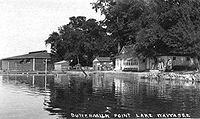
Buttermilk Point
Buttermilk Point was a resortResort
A resort is a place used for relaxation or recreation, attracting visitors for holidays or vacations. Resorts are places, towns or sometimes commercial establishment operated by a single company....
hotel located at the extreme south end of the lake and south shore of Buttermilk Bay. It was owned by Lewis Jarrett, a Civil War veteran and member of an early Wawasee family. In 1893 Lewis died and his wife, Elizabeth, became the owner. At the source of a spring, a log milkhouse was built early on which serviced the passengers in passing steam boats with buttermilk, sweet cream, and butter. Later this site would be home to the Johnson Hotel operated by the Hilbert family. The Johnson Hotel, the
last of the great old hotels was sold at auction in 1971.
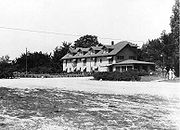 | 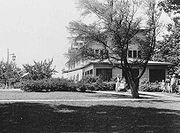 | 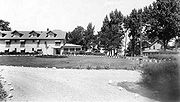 |
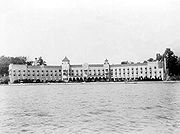 | 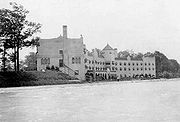 |  |


